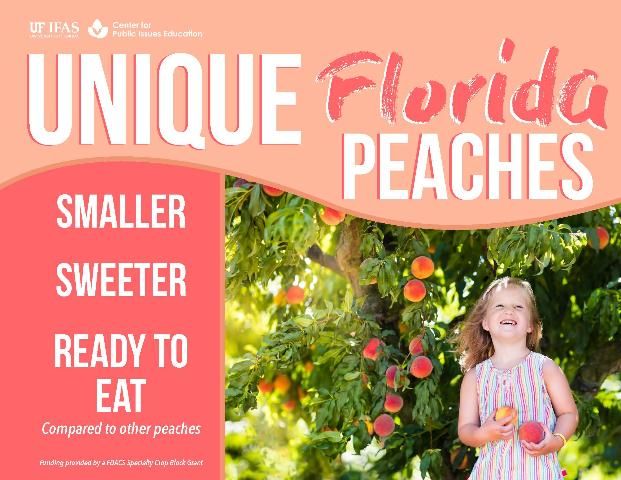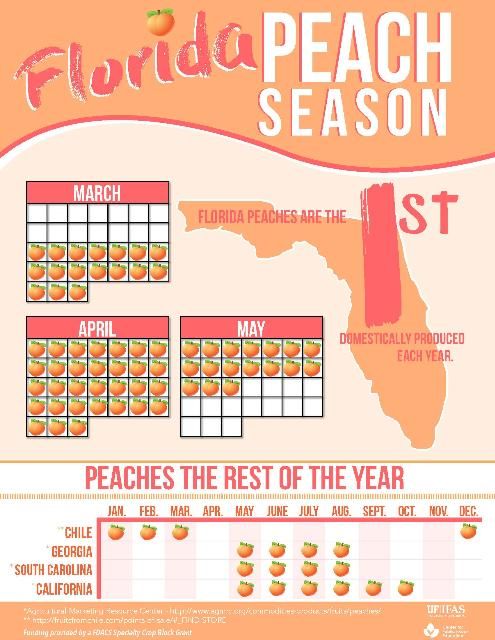This publication can help consumers understand Florida peaches' appeal and help Florida peach producers and marketers understand the competitive advantages of Florida peaches.
Florida Peaches: An Emerging Industry
For many years, peach orchards were limited to geographic areas with an adequate number of "chill hours," or hours below 45 degrees Fahrenheit during the colder months (UF/IFAS, 2017). In 1952, a stone fruit breeding program started at the University of Florida with a goal of breeding trees that would produce peaches and nectarines to grow in Florida (Sarkhosh et al., 2018). In recent decades, horticulturalists have developed peach varieties requiring fewer chill hours, allowing peaches to be commercially produced in Florida (Sarkhosh et al., 2018). Growing peaches in Florida has been identified as a practical option for citrus farmers who have lost groves to citrus greening. As a result, much of the peach production in Florida is in centralized areas where citrus was once prevalent, like central and south central Florida. However, there are also some peach orchards in north and north central Florida (Sarkhosh et al., 2018).
The growing conditions in Florida have given Florida peaches unique characteristics that make them an ideal springtime snack. In this document, we will discuss the unique Florida peach, including its smaller size, seasonality, tree-ripened sweetness, and health benefits. Lastly, we will leave you with recommendations to keep your Florida peaches fresh as long as possible.

Credit: UF/IFAS Center for Public Issues Education
Perfectly Snack-Sized
Florida peaches are commonly much smaller than peaches grown in notable peach states like Georgia or California. Florida peaches tend to be closer to the size of a baseball, while peaches from other states can be softball-sized. The smaller size of Florida peaches makes them a great snack or addition to a school lunch.
The small size is due to a short fruit development period (FDP). The FDP measures the time from when the fruit first starts developing on the tree until it is mature (Sarkhosh et al., 2018). The FDP is also impacted by temperature. Warmer temperatures cause shorter FDPs, while cooler temperatures result in longer FDPs. The faster a fruit develops, the less time it has to grow in size, which results in the trademark smaller Florida peach (Sarkhosh et al., 2018).
The First Domestically Grown Peach Each Year
Florida peach production fills a considerable gap in production between Chilean production (ending in March) and the California, Georgia, and South Carolina season (starting in May). The combination of fewer chill hours and shorter FDP also allows for Florida peaches to be ripe during a unique time of year. With a FDP of around 60 days, Florida peaches are ripe from late March through early May (Sarkhosh et al., 2018).
In an effort to provide peaches year-round, peaches are often imported from other states and countries. For consumers, it can make selecting local or in-season produce more difficult. It is important to recognize the seasonal ranges of peaches to understand where they are likely from and if they are currently in season in your area. From mid-March to mid-May, look for Florida peaches. See Figure 2 to view peach seasonality throughout the year.

Credit: UF/IFAS Center for Public Issues Education
Tree-Ripened = Sweeter
Peaches are considered a climacteric fruit, which means they will continue ripening after harvest but the taste and sweetness will not rise (Sarkhosh et al., 2018). Florida's unique environment allows commercial growers to harvest high-quality, tree-ripe peaches (Sarkhosh et al., 2018), while peaches grown in other locations are typically harvested before they are fully ripe. This means Florida peaches often have a desirable sweetness that cannot always be achieved in all growing locations (Sarkhosh et al., 2018).
Health Benefits of Peaches
Peaches are considered part of a healthful diet; they are high in micronutrients and fiber (1.9 grams for a small peach) while also being low in fat (.33 grams for a small peach) and sugar (10.9 grams for a small peach) (Food and Drug Administration [FDA], 2015; United States Department of Agriculture, Agricultural Research Service [USDA, ARS], 2016). Peaches contain several nutrients that support healthy lifestyles and diets, especially micronutrients such as hydroxycinnamates, procyanidins, flavonols, and anthocyanins (Tomás-Barberán et al., 2001). Peaches are also rich in potassium (247 milligrams for a small peach) as well as vitamins A (424 IU for a small peach) and C (8.6 milligrams for a small peach) and are cholesterol free (USDA, ARS, 2016). These nutrients, vitamins, and minerals have been shown to contribute to overall human health (Tomás-Barberán et al., 2001). Figure 3 highlights some of the health benefits of peaches.

Credit: UF/IFAS Center for Public Issues Education
Purchase and Storage of Florida Peaches
A variety of national chain and local stores carry Florida peaches, including big box stores; however, some large regional chains may not. Due to limited production in the state, the display of Florida peaches may be small, and signs may not indicate clearly whether peaches were grown in Florida. However, the growing location should be indicated on the fruit's sticker. If you cannot find Florida peaches during Florida's peach season, ask the produce manager if they are currently carrying Florida peaches. U-pick operations, farmers markets, and roadside stands also provide excellent opportunities to purchase Florida peaches (Harders, Rumble, Bradley, House, Anderson, & Stofer, 2016).
To maintain the quality of Florida peaches once you purchase them, we recommend the following steps (Peach Advisory Group, 2017).
- Store Florida peaches in the refrigerator. The best temperature for peach storage is 34–36°F. Storing peaches in the refrigerator will help ensure that they do not spoil before you are ready to eat them.
- Do not place peaches in a fruit bowl or stack other fruit or food on top of them. To minimize bruising, peaches should be stored in a single layer.
- Right before eating, gently rinse the peach under clean water.
Conclusion
Florida peaches are a great-tasting, healthy option for a snack, especially when they are in season and others are not. Check your local stores between March and May, and recommend they purchase Florida peaches.
References
Food and Drug Administration [FDA]. (2015). Food guidance & regulation. Retrieved from https://www.fda.gov/food/guidance-regulation-food-and-dietary-supplements
Harders, K., Rumble, J., Bradley, T., House, L., Anderson, S., Stofer, K. (2016). Consumer purchasing survey (17-02). Retrieved from http://www.piecenter.com/wp-content/uploads/2015/09/Peach-Report_FINAL.pdf
Sarkhosh, A., Olmstead, M., Chaparro, J., Anderson, P., Williamson, J. (2018). Florida peach and nectarine varieties. Cir1159. Gainesville: University of Florida Institute of Food and Agricultural Sciences. Retrieved from https://edis.ifas.ufl.edu/publication/mg374
Peach Advisory Group. (2017). Florida peach handling suggestions. Research brief for FDACS specialty crop grant, Tallahassee, FL.
Tomás-Barberán, F. A., Gil, M. I., Cremin, P., Waterhouse, A. L., Hess-Pierce, B., & Kader, A. A. (2001). Analysis of phenolic compounds in nectarines, peaches, and plums. Agricultural Food Chemistry, 49(10), 4748–4760. doi:10.1021/jf0104681
University of Florida, Institute of Food and Agricultural Sciences. (2017). Chill hours, Gardening solutions. Retrieved from https://gardeningsolutions.ifas.ufl.edu/plants/edibles/fruits/chill-hours/
United States Department of Agriculture, Agricultural Research Services. (2016). National nutrient database for standard reference release 28: 09236, peaches, yellow, raw. Retrieved from https://fdc.nal.usda.gov